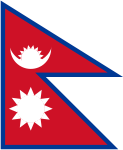- Flag of Nepal
-
Flag of Nepal
Use National flag 
Proportion 5:4 Adopted December 16, 1962 Design Combination of two red pennons with a blue border, defaced with a sun-and-crescent and a sun The national flag of Nepal (Nepali: नेपालको झण्डा) is the world's only national flag that is non-quadrilateral in shape. The flag is a simplified combination of two single pennons, the vexillological word for a pennant. Its crimson red is the colour of the rhododendron, the country's national flower. Red is also the sign of victory in war. The blue border is the colour of peace. Until 1962, the flag's emblems, the sun and the crescent moon, had human faces. They were removed to modernize the flag. The faces remained on the sun and the moon on the Royal Standard until the abolition of the monarchy in 2008.
The flag was adopted, with the formation of a new constitutional government, on December 16, 1962. The individual pennants had been used for the preceding two centuries and the double pennant since the 19th century. The flag borrows the basic design from the original design, which has been in use for more than 2,000 years.[citation needed]
Contents
Interpretation
The blue border symbolizes the peace and harmony that has been prevalent in the country since the age of Gautama Buddha, who was born in Nepal. The crimson red is Nepal's national colour, and it indicates the brave spirits of the Nepalese people. The two triangles symbolize the Himalaya Mountains and represent the two major religions, Hinduism and Buddhism.[1] The red triangular flag has been a Hindu symbol of victory since the time of Ramayana and Mahabharata. The depiction of celestial bodies represents permanence, the hope that Nepal will last as long as the sun and the moon. The moon symbolizes that the Nepalese are soothing and calm, while the sun symbolizes fierce resolve. The moon also symbolizes the shades and the cool weather of the Himalayas, whereas the sun symbolizes the heat and the high temperature at the lower part (Tarai) of Nepal. Another interpretation: The flag's shape symbolizes a Nepalese pagoda. Putting a mirror at the side of the flag closest to the flagpole will generate an image of a pagoda.[citation needed]
To outline the importance of Nepal's Hinduism, Veer Savarkar wrote,
“ To the Independent Hindu kingdom of Nepal all Hindudom feels itself most loyally attached and would ever strive to strain every nerve in defending its honour and integrity. It is the only part of our Mother Land which continues down to this day as a Dharma Kshettra unsullied by the humiliating shadow of an alien non-Hindu Flag. ” Other flags
-
Flag of Mustang, a predecessor state to Nepal, which shares a similar design
References
- ^ http://flagspot.net/flags/np.html
- ^ P. 509 Encyclopaedia of Political Parties By O P Ralhan
External links
National flags and coats of arms National flags National coats of arms Categories:- Flags of Nepal
- National flags
- National symbols of Nepal
Wikimedia Foundation. 2010.


